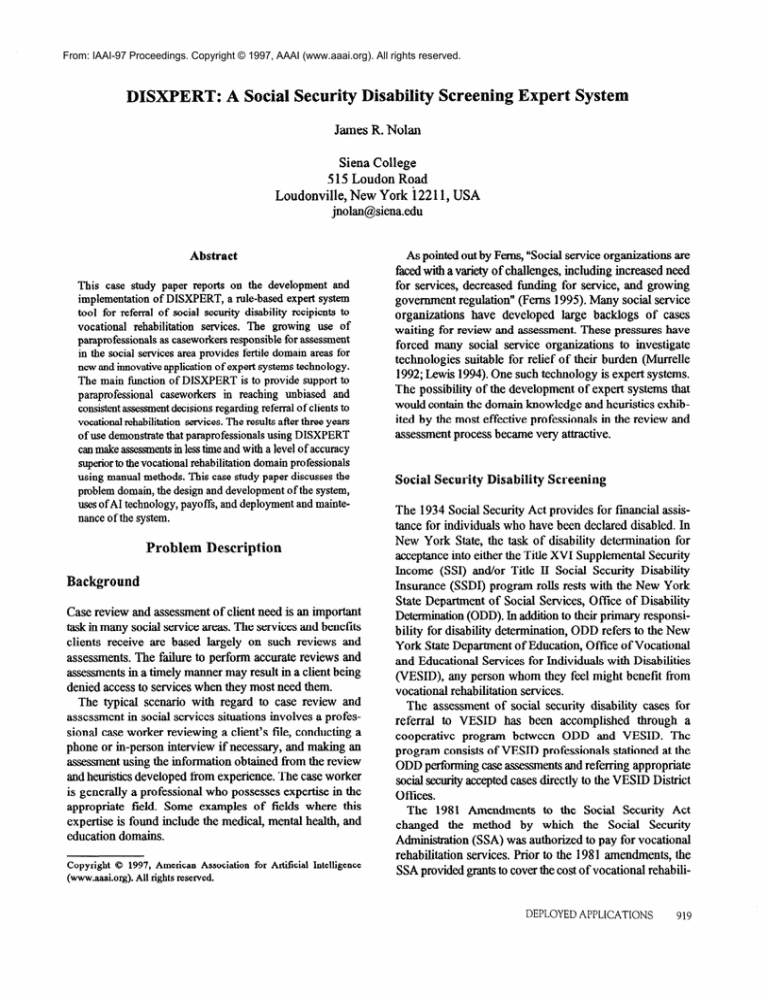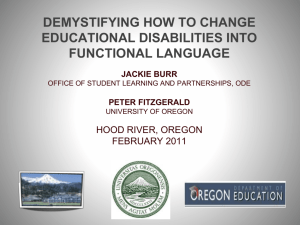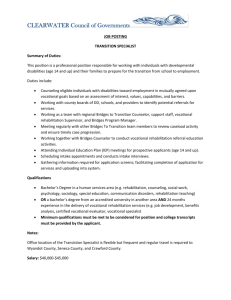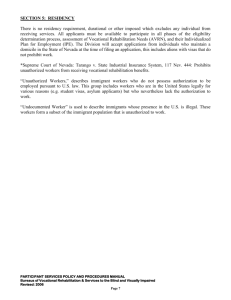DISXPERT: A Social Security Disability ... James R. Nolan Siena College 5 15 Loudon Road
advertisement

From: IAAI-97 Proceedings. Copyright © 1997, AAAI (www.aaai.org). All rights reserved. DISXPERT: A Social Security Disability Screening Expert System James R. Nolan Siena College 5 15 Loudon Road Loudonville, New York 122 11, USA jnolan@siena.edu Abstract This case study paper reports on the development and implementation of DISXPERT, a rule-based expert system tool for referral of social security disability recipients to vocational rehabilitation services. The growing use of paraprofessionals as caseworkers responsible for assessment in the social services area provides fertile domain areas for new and innovative application of expert systems technology. The main function of DISXPERT is to provide support to paraprofessional caseworkers in reaching unbiased and consistent assessment decisions regarding referral of clients to vocational rehabilitation services. The results after three years of use demonstrate that paraprofessionals using DISXPERT can make assessments in less time and with a level of accuracy superiorto the vocational rehabilitation domain professionals using manual methods. This case study paper discusses the problem domain, the design and development of the system, uses of AI technology, payoffs, and deployment and maintenance of the system. Background Case review and assessmentof client need is an important taskin many social service areas. The services and benefits clients receive are based largely on such reviews and assessments. The failure to perform accurate reviews and assessmentsin a timely manner may result in a client being denied access to services when they most need them. The typical scenario with regard to case review and assessment in social services situations involves a professional case worker reviewing a client’s file, conducting a phone or in-person interview if necessary, and making an assessmentusing the information obtained from the review and heuristicsdeveloped from experience. The case worker is generally a professional who possesses expertise in the appropriate field. Some examples of fields where this expertise is found include the medical, mental health, and education domains. Copyright 0 1997, American Association for Artificial Intelligence (www.aaai.org). All rights reserved. As pointedout by Ferns,“Social service organizations are fzed with a variety of challenges, including increased need for services, decreased funding for service, and growing government regulation” (Ferns 1995). Many social service organizations have developed large backlogs of cases waiting for review and assessment. These pressures have forced many social service organizations to investigate technologies suitable for relief of their burden (Murrelle 1992; Lewis 1994). One such technology is expert systems. The possibility of the development of expert systems that would contain the domain knowledge and heuristics exbibited by the most effective professionals iu the review and assessmentprocess became very attractive. isability Screening The 1934 Social Security Act provides for financial assistance for individuals who have been declared disabled. In New York State, the task of disability determination for acceptance into either the Title XVI Supplemental Security Income (SSI) and/or Title II Social Security Disability Insurance (SSDI) program rolls rests with the New York State Department of Social Services, Office of Disability Determination(ODD). In additionto their primary responsibility for disability determination, ODD refers to the New York StateDepartmentof Education, Office of Vocational and Educational Services for Individuals with Disabilities (VESID), any person whom they feel might benefit from vocational rehabilitationservices. The assessment of social security disability cases for referral to VESID has been accomplished through a cooperative program between ODD and VESID. The program consists of VESID professionals stationed at the ODD performing case assessmentsand referring appropriate social securityaccepted cases directly to the VESID District Offices. The 1981 Amendments to the Social Security Act changed the method by which the Social Security Administration(SSA) was authorized to pay for vocational rehabilitation services. Prior to the 198 1 amendments, the SSA provided grantsto cover the cost of vocational rehabili- DEPLOYED APPLICATIONS 919 tationservices for social security recipients. With enactment of the amendments, the SSA was authorized to pay for services only on a case-by-case basis, and only in those instances when vocational rehabilitation services have resulted in the recipient performing at substantialgainful activity (SGA) for a continuous period of nine months. This change inreimbursementmethods had an immediate and dramaticeffect on the level of SSA funding available to New York VESID. SSA, under the grant system, used to provide approximately $5 million per year to New York VESID. Post 198 1 amendments reduced the funding to approximately$1 million per year. The amendments forced New York VESID to reexamine its level of participation in the social security vocational rehabilitation assessment process with ODD. The effect of this reexamination was a sharpcutbackin the number of VESID employees dedicated to the assessment effort. Prior to the 1981 amendments, VESID had 13 professional and 18 clerical staff persons assigned to the process. These staff members assessed approximately 70,000 cases per year. After the 1981 amendments,VESID had 4 professional and 3 clerical staff assigned to this function, assessing approximately 15,000 cases per year. This sharp reduction in case assessment activity had a markedimpacton the New York VESID caseload as well as the amountof vocational rehabilitation services provided to social security recipients. SSIBSDI referrals to vocational rehabilitationservices decreased 47% from the pre-amendmentperiod while successfulrehabilitations for these clients declined over 3 1% during this same period. Assuming thatthe level of funding by the Social Security Administration was not going to increase dramatically and knowing that there was still a desire on the part of New York Stateto reversethe downward trends in the successful rehabilitation of social security recipients, it appeared obvious thatthe method by which clients are first identified and then referred into the vocational rehabilitation system had to be changed. In order for vocational rehabilitationto work, social securityrecipients must be effectively assessed and appropriately referred into programs. Objectives for the New System The economics of the VESID program precluded the dedication of large personnel services expenditures to the assessment process. However, VESID felt it might be possible to perform the review and assessmentfunction at a relativelymodest cost if an effective automatedrisk assessment system could be developed. The objectives to be achieved by the development and deployment of the social security disability screening expert system were: 1) a substantiallylower cost per case assessed. 2) faster processing of cases. 3) greater objectivity and accuracy in the assessment process. 920 INNOVATIVE APPLICATIONS 4) a reportfeatureconforming to the requirements of the New York StateEducation Department and the Social Security Administration. An A.I solution was sought because successful expert systems have been developed in other risk assessment domaius. The assessmeutprocess involves the analysis of client information and the application of certain rules in order to determine what services would most benefit the client. This is an application that fits the criteria for problems suitable for rule-based expert systems solutions. The knowledge base for DISXPERT consists of the results of empirical research in vocational rehabilitation services and the domain knowledge of three expert vocational rehabilitationcounselors. The empirical research was a two stepprocess. First, a survey of the literaturewas conducted to identify factors thought to be important in predicting successful vocational rehabilitation after services are rendered.A listof 22 factorswas identified. Second, a linear discriminant statisticalanalysis of 9,000 past VESID cases was conducted to determine which of these 22 factors helped to discriminate between those individuals who have completed a service program and attainedgainful employment and those individuals who have not completed a service program and/or have not attained gainful employment. This analysis revealed the following statistically significant factors: home geographic area age education work history severity of disability In additionto the empiricalresults,the domain knowledge of expert vocational rehabilitation counselors needed to be captured in the knowledge base. In order to obtain the domain knowledge from the expert vocational rehabilitation counselors,each counselor was given the same 225 disability cases to review and make an assessment. Each of the counselors was asked to explain his or her reasoning for each of the 225 risk assessments.From these sessions, the knowledge and heuristics learned were encapsulated into rules that serve as the knowledge base for DISXPERT (Figure 1). The knowledge base was used to develop a model. This model was tested and went through several iterations with the expertcounselorsmaking changes to the rules as needed. When the expert counselors reached a consensus that the factors and heuristics included in the knowledge base were similarto what they considered in the vocational rehabilitation review and risk assessmentprocess, the development of the expert system began. Figure 1. Overview of DISXPERT knowledge base. Prototype Development The ultimate goal of this project was to provide expert assistance to individuals working in the ODD and VESID field offices. People in these offices had access to IBM PC compatible personal computers. In addition, some, but not all, of the personnel had experience using a personal computer. These two facts required the system to be designedto run on an IBM PC compatible computer platform-one incorporating a friendly, easy-to-use interface. Other attributesof the system that were desired were statistical analysiscapabilities as well as the ability to access external spreadsheetand database files. Finally, since there would be a need for several copies of the disability screening expert system software, it was desired that there be no runtime version charges associated with any commercial packages used. After a careful examinationof the software options, it was decided that lst-Class Expert Systems, Inc. expert system shell,called 1St-ClassFusion, would be used in the development of the disabilityscreening expert system. This package includes software for applying the ID3 inductive learning algorithm to the task of creating rules mirroring relationships present in the data (Michalski 1983). The resulting rules could then be customized and added to fit the heuristics developed from working with the expert vocationalrehabilitationcounselors. An additional feature of the software is the ability to easily create and mod@ input forms as well as report summaries. Finally, the inputs and resulting decisions could be saved in a form suitable for further analysis. A prototype system was developed using the lst-Class fusion product. The ID3 inductive learning algorithm was employed to produce rules comprising relationships among the previously identified statisticallyrelevant factors (Nolan 1991). These rules were combined with those generated by the vocational ilitation domain experts. This prototype showed a high degree of agreement with the 225 cases used in part to create it. Specifically, the prototype disability screeningexpertsystemreferred to vocational rehabilitation services 93% of the clients who had benefited from these services in the past. While it is not unusual for a classiflcation model to do well when examining the cases used to createit, the resultsdid show that we had a viable prototype to continue development. The prototypeutilized a client information screen (Figure 2), severaldataacquisition screens (Figure 39, and provided screenoutputand offered hardcopy output of the assessment (Figure 4). In addition, all data entered and decisions made were stored to a database for later retrieval. Other features included an on-line “HELP” section which explained to the paraprofessional user the reason for asking a question DEPLOYED APPLICATIONS 921 New York State Education Department Vocational Educational Services for Individuals with Disabilities [Fl=Help] [Esc=Stop] Automated Screening System INDIVIDUAL’S SOCIAL SECURITY NUMBER: NAME: ADDRESS STREET: CITY: STATE: ZIP: PHONE: VESID DISABILITY CODE: DSS ENTITLEMENT: PIUMARY DISABILITY: SECONDARY DISABILITY: KEYBOARD SPECIALIST’S INITIALS: Figure 2. DISXPERT client information screen. New York State Education Department Vocational Educational Services for Individuals with Disabilities [Fl=Help] [Esc=Stop] EDUCATION EDUCATION IS CLASSIFIED INTO FOUR CATEGORIES. ANYONE WHO IS CURRENTLY OR HAS BEEN ENROLLED IN SPECIAL EDUCATION SHOULD BE INCLUDED IN THE UP-TO-8 CATEGORY. HIGH SCHOOL AND COMMUNIT Y COLLEGE GRADUATES ARE CLASSIFIED IN THE 12_TO-15 CATEGORY. FOUR YEAR COLLEGE GRADUATES AND BEYOND SHOULD BE CLASSIFIED AS 16_AND_OVER UP-TO-8 9_TO_ll 12_TO-15 16_AND_OVER 17 Figure 3. DISXPERT education classification screen. 922 INNOVATIVE APPLICATIONS New York State Education Department Vocational Educational Services for Individuals with Disabilities Automated INDIVIDUAL’S SOCIAL SECURITY NUMBER: Screening System 999-99-9999 NAME: John C. Doe ADDRESS STREET: 12 Maple Avenue CITY: Homer ZIP: 11221 STATE: New York PHONE: (518)555-4543 VESID DISABILITY CODE: 8190 DSS ENTITLEMENT: SSDI PRIMARY DISABILITY: 7655 SECONDARY DISABILITY: 3456 KEYBOARD SPECIALIST’S INITlALS: JRN FACTOR ASSIGNMENTS AGE: 16-40 EDUCATION: 12-15 PROGNOSIS: UP-TO-3 IMPAIRMENT: 2480 ASSESSMENT SCREEN IN FOR REFERRAL TO APPROPRIATE PROGRAMS Figure 4. A sample of a DISXPERT The main AI research results that this application depends on are in the areas of machine learning and rule-based expert systems. The fact that we were able to obtain a set of rules from the social security disability assessment experts dictated that a rule-based expert system be deployed. The success of the application also depended on the development of additional rules for classification using past client data. The ID3 inductive leaming algorithm allowed us to develop rules for assessment and classification that could not be explicitly elicited from the expert rehabilitation counselors. The project could not have succeeded without these AI techniques. The combining of lcuowledge gained from statistical learning techniques with knowledge acquisition from final assessment as displayed on the screen. experts was necessary because each represents a facet of the total knowledge needed to make effective social security disability assessment decisions. The statistical analysis of 9,000 past VESID cases and the deployment of the ID3 inductive learning algorithm was done in order to obtain historical knowledge about the success and failures of past assessment decisions. Acquiring the expert rehabilitation conselors rules for making assessment decisions was an attempt to encode knowledge about current social security disability assessment practice. In particular, the medical knowledge used by these experts is important because rehabilitation possibilities change as new therapeutic techniques are discovered. Combining knowledge gained from different AI methods increases the chances of building effective expert systems. Even though the human experts are well trained, they may DEPLOYED APPLICATIONS 923 not be aware of significant information that can be obtained from other AI techniques such as statistical learning. Application Use and Payoff DISXPERT was implemented in all VESID and ODD offices starting in 1992. Prior to the 1981 Social Security Act amendment funding changes, 13 professional and 18 clerical staff handled the VESID disability review and assessment process. They averaged 70,000 cases assessed each year. After the 1981 amendments to the Social Security Act were implemented, the number of professional and clerical staff were reduced to four and three, respectively. The assessment output dropped to 15,000 cases a year. After DISXPERT was in operation in all VESID and ODD offices, the number of assessed cases per year jumped to 78,000 with a slight increase in staff to six professional and five clerical people. By any measure, this is a tremendous Priorto 1981 After 1981 DISXPERT era Professional Clerical Cases Staff Staff Assessed 13 18 70,000 4 3 15,000 6 5 78.000 Table 1. Staffing and Cases Assessed Increased efficiency is not the only result of using DISXPERT. The effectiveness of the assessment process has also been improved. In fact, the dropout rate, i.e., the percentage of those referred into education and training programs who did not complete them, has declined over 80%. These results mean that more beneficiaries who have the potential for gainful employment will have the opportunity to enroll in vocational rehabilitation programs. This, in turn, increases the amount of funds reimbursed to New York State from the federal government. Application Development and Deployment Proper testing and validation of any expert system is important for dete rmining the accuracy, completeness, and performance of a system (O’Leary et al. 1990). It is not uncommon for significant changes to be made to systems based on test results. This expert system was no exception. A single VESID office was selected as a test site. It was felt that the employees selected to be involved with the 924 INNOVATIVE APPLICATIONS testing should feel comfortable using a personal computer (Chaiklin 1993). In light of this, training in the usage of personal computers was provided. All social security disability cases referred to this office were sent through the DISXPERT system. Over a nine month period, a total of 12,43 1 cases were reviewed and a risk assessment made. During this testing process, two major changes were made to the DISXPERT system. The rules for orthopedic disabilities were modified to better match the thinking of the expert vocational rehabilitation counselors. Secondly, DISXPERT was modified to examine the new disability coding scheme established by the Social Security Administration. Using this new coding scheme allowed DISXPERT to more clearly delineate disability cases. At the end of the nine month testing period, the three vocational rehabilitation counseling domain experts agreed the system was very effective at assessing whether referral should be made to vocational rehabilitation services. A controlled experiment was set up to determine just how good DISXPERT was operating compared to domain experts. Two hundred cases were selected for the experiment. The three vocational rehabilitation experts reviewed each of the two hundred cases and made an assessment. The same two hundred cases were independently reviewed and assessed by DISXPERT. The results indicated that DISXPERT agreed with the domain experts on 198 of the 200 cases for an agreement rate of 99%. Given this success, it was decided that DISXPERT would be used by all VESID and ODD district offices in New York State. The costs associated with the development and deployment of DISXPERT can be separated into so&are and hardware development costs and training costs. The expenses associated with the purchase of hardware and software, the development of the rule-based expert system including knowledge acquisition and development of the rule base and user interface, totaled $60,000. The training of district office personnel in the use of DISXPERT totaled approximately $30,000 in costs and associated staff time. Total cost for the entire project was approximately $100,000. One of the main difficulties in the development of any expert system is the level of acceptance the users will have for the new system. Knowing this to be a key ingredient in the potential success of the computerized assessment system, a concerted effort was made from the beginning of the project to involve several potential users in the development of the model. This caused a f‘eeling of “ownership” to take hold and, frankly, was the key to acceptance of the system. This is a lesson well worth remembering. Maintenance The knowledge base is maintained by individuals at the user site. At the end of each year, the rules are reviewed for accuracy.This is done by comparing the results of previous assessmentdecisions with respect to successful placement. If there is evidence that the system is under performing in any area, the rules associated with it are checked. The design of the application facilitatesupdates because the system is rule based. It is relatively easy to change selected rules because the expert system shell used to develop the system allows quick access to rules. They can be changed or deleted or new rules can be added. In the three plus years DISXPERT has been deployed, there has been only one occasion where a few rules were slightly modified. In the future, changes in social security disability training and education programs and objectives could lead to more substantialchanges in the rules used to assess client needs. Again, the structure of a rule-based expert system provides a framework amenable to g these changes. Summary This work has shown that paraprofessionals can, with the aid of an expert system, make accurate risk assessment decisions,and in less time. In particular,the results demonstrate the utility of AI technology in the social service organization. There are several areas where systems like DISXPERT may have an impact. First of all, many services provided by social service agencies are offered only a&r some form of assessment or screening takes place. Generally, the screeningprocess serves to identify those individuals who are in need and could benefit the most from a service or services. DISXPERT provides for less timeconsuming screening and assessment. This leads to quick accessto needed services and also enables the social service agency to handle increasingly heavier screening and assessmentworkloads. A second area of impact is the quality of screening and assessment activities. It does not do the social service agency any good to assess more applicants in a shorter amountoftime ifthc accuracy ofthe assessmentis compromised. The use of DISXPERT by the VESID offices has resulted in an increase in the quality of the screening and assessment process as measured by the decrease in the dropout rate, i.e. the percentage of those screened into education and training programs who did not complete them. Finally, systems like DISXPERT help to structure a process for more uniform high quality results yet have the flexibilityto be changedwhen needed. This is accomplished through the ability to accurately monitor all screening and assessmentdecisions. The software generates statisticsthat can later be matched to service outcomes. If changes are needed in the assessment process, the system is flexible enough to allow changes to any of the heuristics. The DISXPERT expert system provides several benefits to both the social service agency and the client: 1) increases e accuracy of paraprofessionals screening clients into rehabilitation programs that lead to successful outcomes; 2) reducesthe amountof time needed to e an assessment; improves the collection and recording of client data; 3) 4) enhancesthe trainingof less experienced caseworkers by lettingthem “see”how assessmentsare made by the domain experts; serves as a repository of clinical and service knowl5) edge and practice, documenting the policies and procedures of the agency. This knowledge is preserved for archival and future use. The results indicate that certain types of decision problems may benefit l?om employing more than one knowledge acquisition strategy. In particular, the combination of statisticallearning methods and rule-based approaches has resultedin a systemwhich proves to be even more effective than the experts whom the system is designed to imitate. eferences H. 1993, SystemsAnalysts are Perilous for Social Welfare Qrganizations. Computers in Human Services 9(3- 4):479-487. Ferns, W. J. 1995. Lifenet: Tool For Risk Assessment of Adolescent Suicide. Expert Systems with Applications 9(2): 165-176. Lewis, 6. 1994. Assessing Psychiatric Disorder With a HumanIntervieweror a Computer.Journal of Epidemiology and Community Health 48(2):207-2 10. Michalski, R. S.; Carbonell, J. 6.; and Mitchell, T. M. eds. 1983. Machine Learning: An Artificial Intelligence Approach. Palo Alto, Calif: Morgan Kaufmann Publishers, Inc. Murrelle,L.; Ainsworth, B. E.; Bulger, J. D.; and Ho S. C. 1992. ComputerizedMental Health Risk Appraisal fo; College Students:User Acceptability and Correlation with Standard Pencil-and-Paper Questionnaires. American Journal ofHealth Promotion 7(2):90-92. Nolan, J. R. 1991. An Application of the ID3 Inductive LearningAlgorithm to a Service Sector Operation. In M. B. Fishman eds. Proceedings of the Fourth Florida Artificial Intelligence Research Symposium, 96-99. O’Leary, T. J.; Goul, M.; Moffiq E.; and Radwan, A. E. 1990. Validating Expert Systems. IEEE Expert 5,51-58. DEPLOYED APPLICATIONS 925



